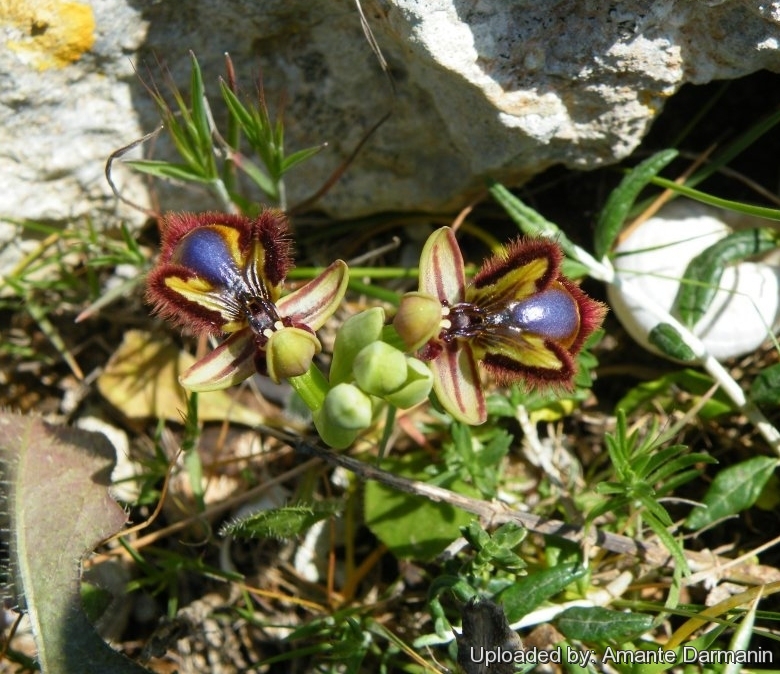
Ophrys speculum Photo by: Amante Darmanin
Mirror orchid (Ophrys ciliata) Near Ta Cenc, Gozo, Malta.
Origin and Habitat: Ophrys speculumSN|35004]]SN|35001]] is widespread around the Mediterranean, and is particularly prolific in the Algarve region of Portugal. It becomes more scarce in the east. Other countries in Europe where this orchid is known to occur include Spain, Italy, Malta, Cyprus, Greece and Turkey.
Altitude range: From sea level up to 1150 metres above sea level.
Habitat and ecology: Ophrys ciliataSN|35001]]SN|35004]] is locally common in stony and rocky places in thickets, garrigue, meadows, bushes and open pine forests, on dry to moist calcareous soil in full sunlight or light shade. The plants often grow in groups. It blooms in spring (from March to April).
Synonyms:
See all synonyms of Ophrys speculum
Description: (Ophrys speculumSN|35004]]SN|35001]] (syn: Ophrys ciliataSN|35001]]SN|35004]]) is a perennial herb, growing from a tuber reaching a height of 5-25 cm. The flowers are highly visible as the light reflects off the speculum in the centre of the lip that is a bright iridescent purple/blue in colour and very glossy. The lip is three-lobed and bordered by a greenish-yellow border which is surrounded by a band of thick velvety hairs which are reddish brown. The sepals and petals are green and marked with violet spots or stripes. Its insect- mimic flowers emit optical and olfactory stimuli to attract male wasps (Dasyscolia ciliata) looking to mate. The flower of this orchid mimics the top of the female insect's abdomen: blue iridescent wings folded over a hairy body. It also emits a stimulating scent compound attractive to the wasp. Although this is a case of mistaken identity for the wasp, it's a successful case of pollination for the flower. [2]
Leaves: Basal leaves oblong with obtuse apex, cauline leaves (of the stem) lanceolate with acute apex.
Inflorescence: Sparse, usually few flowered (2-8 flowers).
Flowers: Sepals oblong, obtuse, green with two reddish-brown streaks, the lateral reclined downwards, the median one curved on the ginostemium with a thickened margin. Petals about half as long a the sepals, ribbon-shaped, brown, pubescent, truncated at the apex. Labellum trilobed, up to 16 mm long, entirely surrounded by thick and long reddish-brown hairs, lateral lobes inserted in the basal half, more or less triangular, median lobe much larger, obovate, occupied almost entirely by the glabrous, glossy, blue macula, violet with metallic reflections, with yellow-orange border; Ginostemium short, and obtuse.
Subspecies, varieties, forms and cultivars of plants belonging to the Ophrys speculum group
 Ophrys speculum Link: (subsp. speculum)It has dark petals and a lobe from the lip moderately convex, with marginal brownish hairs. Distribution: circum-Mediterranean (Morocco and the Iberian Peninsula to Anatolia and Lebanon).
Ophrys speculum Link: (subsp. speculum)It has dark petals and a lobe from the lip moderately convex, with marginal brownish hairs. Distribution: circum-Mediterranean (Morocco and the Iberian Peninsula to Anatolia and Lebanon). - Ophrys speculum subs. lusitanica O.Danesch & E.Danesch: The fringes on the edge of the lip is light red and the side sections of the lip is dark green and less yellow. Distribution: Algarve region of Portugal and the Extremadura region of Spain at elevations of 0 to 800 meters.
- Ophrys speculum subs. regis-ferdinandii (Acht. & Kellerer ex Renz) Soó: The fringes on the edge of the lip is light red and the side sections of the lip is dark green and less yellow. Distribution: Eastern Aegean Islands at elevations of 0 to 800 meters.
Bibliography: Major references and further lectures
1) Melchiorre Trigilia, “Le Orchidee degli Iblei” Trigilia Cultura
2) Maryjo Koch, “Love Bugs: A Bug-Eyed View of Romance” Andrews McMeel Publishing, 14 September 2010
3) American Orchid Society Bulletin, Volume 57, 3rd Edition, American Orchid Society, 1988
4) Henrik Aerenlund; Henrik Ærenlund Pedersen; Niels Faurholdt. “Ophrys: the bee orchids of Europe”. Royal Botanic Gardens, Kew. 2000.
5) Ayasse M; Schiestl FP; Paulus HF; Ibarra F; Francke W . “Pollinator attraction in a sexually deceptive orchid by means of unconventional chemicals”. Proc. R. Entomol. 2003.
6) Wikipedia contributors. "Ophrys speculum." Wikipedia, The Free Encyclopedia. Wikipedia, The Free Encyclopedia, 27 Feb. 2018. Web. 10 Mar. 2018.
Cultivation and Propagation: Uses: The mucilage- rich tubers are dried and ground to make salep, a traditional flour-like food.








